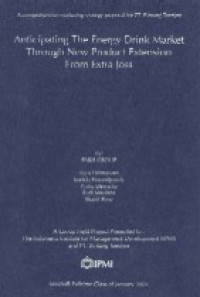
Strategy for Amino Acid Solutions: a case of pan amin G at PT. Otsuka Indonesia
| Gmd : Text
| Availability :
| 00000008678 | 117 | (GFP) | Available - Ada |
Sales contribution of Amino acid solutions to total sales of PT Otsuka Indonesia (PTOI) was less than 7% in 1994, while on the other the hand PTOI was very much depended on basic solution group (electrolytes, carbohydrates, either alone or in combinations) which sales contribution was more than 60%. Market of basic solutions, however, was relatively matured indicated by industry-wide low margin.
Management of PTOI, therefore, felt that it was the time to reduce its dependency on basic solutions and shifted its focus on clinical nutrition which is more profitable and the market was not yet fully developed. The question then, what kind of strategy should PTOI take to be successful in clinical nutrition market, which at that time was dominated by Pfrimmer. The management considered that pricing strategy was one of a primary concern.
In average, patient will need 2 bottles of Pan Amin G per day, for 3 to 5 days or even longer. It means that, if Pan Amin G price was set up at average market price, patients should spend approximately Rp. 50,000 per day for parenteral nutrition only, in addition to fee for hospitalization, medicines, doctors, laboratories examination etc. Hence, it is quite understandable that most of the doctors were reluctant to give parenteral nutrition support to the hospitalized patients because of price issue. The existence of this price issue is confirmed through market research doing by field forces of Otsuka.
It was also true that awareness of importance of nutrition support for hospitalized patients had not been well spread among doctors, especially surgeons and internists. Knowledge of nutrition support is relatively higher among anesthesiologist, even though they do not really have patients since they only provide service to the surgeon during the surgery and when the patients is still in intensive care unit.
Another problem facing the doctors was the, difficulties in evaluating clinical effects of nutrition support to the patients. Existing methods were not reliable in showing improvement of nutrition status of the patients after being given parenteral nutrition. Even though several more reliable parameters were already available, very few doctors were using them, mostly because they do not know that such parameters were already exist and partly because of their expensive costs.
Therefore, many patients, sadly, received only carbohydrates and/or electrolytes solutions for three to four days after surgery, or even more, resulting in slow wound healing and more susceptibility to infectious disease as well as prolonged hospital stay.
One of the decisions that has to be made was should Pan-Amin G in plastic bottle be sold at average market price and maximizing profit (market skimming strategy), with selling price of around Rp. 25,000 per bottle or should it be sold significantly cheaper to that of existing products to gain market share and at the same time also expand the market (market penetration strategy), considering that market of parenteral nutrition in Indonesia was still extremely low.
Those were the issues facing PTOl's management in setting up the overall strategy in strengthening its position in clinical nutrition market, and at the same time reducing its dependency on its basic solutions products.
Research Location: PT. Otsuka Indonesia
Supervisor: Wagiono Ismangil
Accepted on July 1996
For IPMI Internal -- Read at Library Only.
| Series Title |
-
|
|---|---|
| Call Number |
117
|
| Publisher Place | Jakarta |
| Collation |
57p.: tabs., figs.; 27 cm.
|
| Language |
English
|
| ISBN/ISSN |
-
|
| Classification |
NONE
|
| Media Type |
-
|
|---|---|
| Carrier Type |
-
|
| Edition |
-
|
| Subject(s) | |
| Specific Info |
-
|
| Statement |
-
|
| Content Type |
-
|
No other version available







